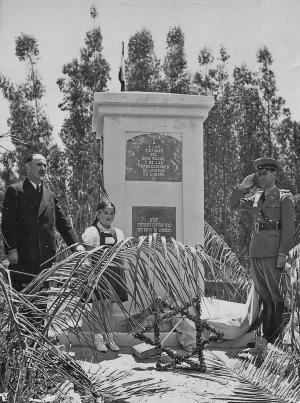Obj. ID: 42836
Jewish Funerary Art Holocaust Memorial in the Jewish Section of La Magdalena Cemetery in Quito, Ecuador, 1943

Who is Commemorated?
Victims of racial hate and religious persecution in Europe.
Description
The monument is a rectangular block with inscriptions in Spanish and Hebrew. The Spanish inscription is decorated with the Jewish symbols - Magen David and Menorah - but conveys a very broad message commemorating "victims of racial hate and religious persecution in Europe", while the Hebrew inscription refers to "murdered and burned and butchered for the sanctification of the Name," thus speaking in more "Jewish" terms.
Inscription
The inscription in Spanish reads:
A las
victimas
del
odio racial
y de las
persecuciones
religiosas
en Europa.
Translation: To the victims of racial hatred and religious persecutions in Europe.
The inscription in Hebrew alludes to the memorial prayer Yizkor in memory of Jewish martyrs and reads:
לזכרון
נצח הנהרגים והנשרפים
והנשחטים על קדשת השם
[....]
Translation: In eternal memory of murdered and burned and butchered for the sanctification of the Name [....]
Commissioned by
Quito Jewish Community
sub-set tree:
Until 1906, the Ecuadorian Constitution declared Roman Catholicism as the only religion of the state. Therefore, in order to immigrate to the country and acquire citizenship, being Catholic was the main requisite. It was only after 1914, when the Panama Canal was inaugurated, that Ecuador began witnessing European immigration on a large scale. According to the government’s official data, only four Jewish families were living in Ecuador in 1904. Even in 1917, a total of only 14 people of the Jewish religion were known to be living in the country. According to the Israeli historian Haim Avni, between 1933 and 1945, Ecuador hosted 3.200 European Jewish refugees, mostly coming from Germany, Austria, Czechoslovakia, and Italy.
One of the activists, who stood behind erecting the monument was Dr. Alfred Karger, who left Berlin with his family in October 1941. This monument was erected by the Quito Jewish Community and unveiled in September 1943 before the High Holidays in the Jewish section of the La Magdalena Municipal cemetery, thus this monument is among the first Holocaust memorial in the world.
The ceremony was attended by a representative of the President of Ecuador. The ceremony was concluded by Ecuador’s national anthem “Salve, Oh Patria” and “Hatikvah” in Hebrew. The ceremony was covered by Ecuador’s newspapers and radio stations.
The Jewish Section of the La Magdalena Municipal cemetery was dissolved years later, and burials were transferred to the Jewish section of El Batán Municipal Cemetery. The monument got lost or destroyed.
Alexander, Gabriel E. "Shoah Memorial in Quito, September 1943: One of the First in the World," Jews of Ecuador Holocaust, September 25, 2010, https://sites.google.com/site/jewsofecuadorholocaust/ (accessed January 6, 2022)
Migliori, Michele, "Ecuador: (European) Jewish Heritage in “an Unknown Country”," Jewish Heritage Europe. April 1, 2020, https://jewish-heritage-europe.eu/cemeteries/resources/essays-and-op-eds/ecuador/ (accessed January 6, 2022)


